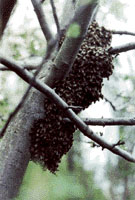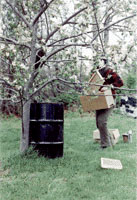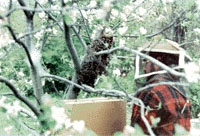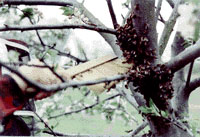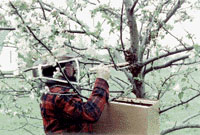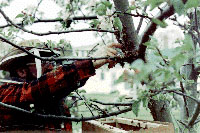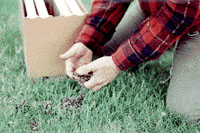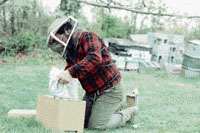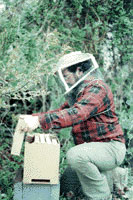Hiving a Swarm (c. 1981)
(Click on the thumbnail images for a closer look.)
One spring day in the early 1980s, New Jersey beekeeper Warren Davy was making the rounds of his beeyards — clusters of 20 to 30 hives kept in different locations to make the most of the honey flow. The last yard was near his sister's house. When he parked the truck, Warren pointed to a crabapple tree and said to look closely.
I walked close to the tree, as he got some equipment from the back of the truck.
About the same time as I could make out the movement in the odd-looking brown lump, I could hear the buzzing. I knew I was looking at a swarm, the first I'd ever seen up close.
Warren reminded me that swarming bees do not sting. Just before they leave the hive, they fill up on honey, and it tranquilizes them. Besides, bees sting to protect their hive, and swarming bees have no hive.
I started shooting pictures as Warren came back from the truck, carrying the smoker and his beekeeper's veiled hat.
"Well, one of the poor things might get caught in my hair and get confused." And with that he rolled an empty oil drum from his sister's shed up under the swarm, spread an old rag across the top of the drum, and got to work.
In spring, when the new queen bees are hatching, and hives are prone to swarming, beekeepers carry boxes of various sorts with them to deal with swarms they happen to come across. This year's model was a waxed corrugated cardboard box made especially for the task, so that five of the wooden frames that are used in standard beehives fit neatly inside.
After he positioned the swarm box directly under the swarm, Warren started putting the bees into the box, using a brush with very soft bristles. First, he used it like a trowel, scooping gobs of bees away from the swarm, then, as most of the bees had fallen into place, he gently brushed at what was left of the swarm.
After a while, when most of the swarm was off the tree, the brush proved too coarse a tool, so he switched to a paint stirrer, gingerly lifting small clusters of bees from the tree trunk and shaking them into the box with their sisters.
And when almost all the bees were off the tree, Warren used his fingers to gently pry individual bees from tricky crevices.
It's important to gather as many bees back into the swarm as possible, for every bee adds to strength of the new hive, and it's important for the stragglers, too.
A bee who gets separated from her swarm can fly to another hive and — by making the proper gestures of submission — generally be accepted by the bees there, but this must happen before the honey that fuels her runs out, or she will die.
Some bees had continued to spill over the edge of the box, off the end of the oil drum, onto the ground, so Warren scooped them up, too.
Almost finished, Warren lifts the rag from the oil drum, brings the cloth over to the swarm box, and gently shakes the last few bees clinging to it into the box with the rest of the swarm.
After one last check for stragglers, Warren heads back to the truck, letting the swarm rest in the box for a few minutes of quiet before he moves them again . . .
. . . to their new location, atop a concrete cinder block in a quiet corner of the beeyard.
A newly hived swarm will take several weeks to strengthen and to grow in numbers enough to warrant a full hive of their own. With proper care, a swarm like this one can be producing enough honey by fall to justify extracting some of their harvest for the table.
(This posting first made its way to the web in 1997, as part of my original web site at databear.com. After the turn of the century, I migrated it to davidmilley.com, where it’s lived ever since.)

